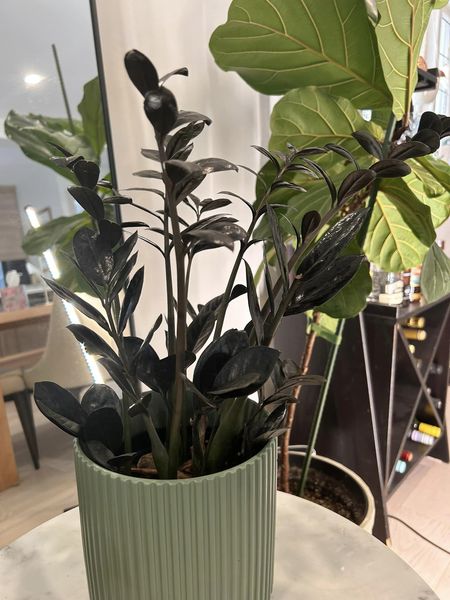
Winter’s chill is upon us, and as we cozy up indoors, our houseplants need a little extra attention to thrive. Among them, the ZZ plant (Zamioculcas zamiifolia) stands out for its resilience and low-maintenance nature. However, even the hardiest of plants require some seasonal adjustments to stay healthy and vibrant. If you’re wondering how to keep your ZZ plant in top shape during the colder months, you’re in the right place. Let’s dive into the essentials of winter care for your ZZ plant.
Introduction: The ZZ Plant – Your Winter Warrior
The ZZ plant, known for its glossy, dark green leaves and forgiving nature, is a favorite among plant enthusiasts. It’s often hailed as a “nearly indestructible” plant, capable of surviving in a range of conditions. But even this robust plant needs some special care when winter arrives. In this guide, we’ll explore how to adapt your care routine to ensure your ZZ plant not only survives but thrives through the winter season.
Understanding the ZZ Plant’s Needs in Winter
What Makes Winter a Challenge for Plants?
Winter presents a unique set of challenges for indoor plants:
- Reduced Light: Shorter days mean less natural light, which can affect plant growth.
- Lower Humidity: Indoor heating systems can dry out the air, impacting plants that prefer higher humidity.
- Temperature Fluctuations: Drafts and sudden temperature changes can stress plants.
Why is the ZZ Plant Special?
The ZZ plant is well-adapted to handle fluctuations in light and moisture. Its thick, waxy leaves store water, making it particularly drought-tolerant. However, winter conditions can still test its limits. Understanding its natural resilience helps in making the right adjustments.
How To Care For ZZ Plant In Winter
1. Adjust Lighting Conditions
How Much Light Does Your ZZ Plant Need?
Even though ZZ plants can tolerate low light, they do better with indirect, bright light. In winter:
- Positioning: Place your ZZ plant near a window that gets indirect sunlight. Avoid direct sunlight, which can be harsh and cause leaf burn.
- Supplemental Lighting: If natural light is sparse, consider using grow lights to provide the necessary illumination. LED grow lights are energy-efficient and effective.
What About Artificial Lighting?
If natural light is insufficient:
- Light Duration: Aim for 12-14 hours of artificial light daily.
- Distance: Keep grow lights about 6-12 inches above the plant to mimic natural light intensity.
2. Manage Temperature and Humidity
Optimal Temperature Range
ZZ plants prefer temperatures between 60-75°F (15-24°C). In winter:
- Avoid Drafts: Keep your plant away from windows and doors where cold drafts can cause stress.
- Consistent Temperature: Maintain a stable temperature. Avoid placing the plant near heating vents or radiators, as sudden temperature changes can be harmful.
How to Maintain Humidity?
While ZZ plants are tolerant of dry air, excessively low humidity can affect their health:
- Humidity Trays: Place a humidity tray filled with water near the plant to help increase moisture in the air.
- Room Humidifier: Using a room humidifier can maintain a more consistent humidity level.
3. Adjust Watering Practices
How Often Should You Water?
Winter’s cooler temperatures and reduced light mean slower growth for ZZ plants, which translates to less frequent watering:
- Check Soil Moisture: Allow the top 2 inches of soil to dry out before watering. Overwatering can lead to root rot.
- Watering Frequency: Typically, watering once every 2-3 weeks is sufficient. Adjust based on your plant’s specific environment.
Signs of Overwatering or Underwatering
- Overwatering: Yellowing leaves, soggy soil, and a musty smell indicate too much water.
- Underwatering: Wilting leaves, dry soil, and leaf drop suggest insufficient watering.
4. Fertilizing During Winter
Should You Fertilize Your ZZ Plant?
Winter is not the ideal time for vigorous plant growth, so fertilizing should be minimal:
- Frequency: Reduce or stop fertilization during winter. Resume feeding in the spring when growth picks up.
- Type of Fertilizer: If you choose to fertilize, use a balanced, diluted liquid fertilizer. Avoid high-nitrogen formulas which can promote excessive leaf growth at the expense of root health.
5. Inspect and Maintain
Regular Check-Ups
Even though ZZ plants are low-maintenance, regular checks can prevent potential issues:
- Leaf Inspection: Look for signs of pests such as spider mites or mealybugs. Treat infestations promptly.
- Clean Leaves: Dust can accumulate on leaves, reducing their ability to photosynthesize. Gently wipe leaves with a damp cloth to keep them clean.
6. Repotting and Soil Considerations
When and How to Repot
Winter is generally not the best time for repotting due to the plant’s slower growth:
- Timing: If repotting is necessary, wait until spring. However, if the plant is severely root-bound, repot in winter using a well-draining potting mix.
- Soil Type: Use a mix designed for succulents or cacti, which ensures proper drainage.
Conclusion: Embracing Winter with Your ZZ Plant
Caring for your ZZ plant during winter doesn’t have to be a daunting task. By adjusting light conditions, managing temperature and humidity, modifying watering practices, and keeping an eye on overall plant health, you can ensure your ZZ plant remains a thriving, vibrant part of your indoor space.
Winter is a time of rest and recovery for many plants, and your ZZ plant is no exception. With these simple adjustments, you’ll help your plant navigate the winter months with ease, ready to burst into new growth when spring arrives. Enjoy the serene beauty of your ZZ plant as it gracefully adapts to the season, and remember: even in the coldest months, a little care goes a long way.
